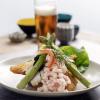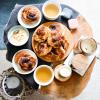
10 of the best Danish cheeses
Denmark is one of Europe's great cheese nations. It's true! If you haven't tried anything beyond Danish Blue, make it your mission to go on a Danish cheese-tasting adventure when you next visit. You won't regret it.
1. Rygeost
Danish Rygeost, or 'smoked cheese' is a real one-off. Mild in taste with a delicate smoky note, and light and airy in consistency, it's the only cheese in Denmark that has not been inspired by foreign flavours. Created in the 19th century in the farms of Fyn, some people believe that this type of cheese can even be traced back to the Viking Age. Where to try it? Gundestrup Dairy has won several awards for its traditional production of smoked cheese. You can also buy it in many supermarkets and you'll find it on the menu of restaurants including noma.
2. Fynbo
This traditional Danish cheese also comes from Fyn. It is a semi-hard cheese made from cow's milk with a mild taste reminiscent of buckwheat. The cheese is ripened for several months and is often used in salads or on bread.

Photo:Claes Bech-Poulsen

Photo:Claes Bech-Poulsen
3. Danbo
Danbo is often called "Denmark's national cheese". We love this mild, slightly sour cow's milk cheese and you can find it in every supermarket and in many a Dane's lunch box.
4. Esrom
This semi-hard cheese made from cow's milk, also known as Danish Port Salut, is known for its yellowish rind and its characteristically strong taste. It was named after Esrum Monastery in North Zealand where cheese is still produced according to a traditional recipe today .
5. Havarti
Havarti is one of the most famous Danish cheeses. It's a bit like a cheddar: the taste can be mild, but the longer it cheese is stored, the stronger it gets. Grab the 'Gammel Knas' variety if you can - crispy protein crystals in the cheese give it a delicious crunch. Havarti goes well with apples, honey, pickled vegetables and red wine.

Photo:@chris.anias (Christoffer Anias Sandager)

Photo:© Mette Johnsen
6. Danablu
Danish Blue is a soft blue cheese was inspired by Roquefort, with a strong aroma and a sharp and a little salty taste. It's ideal for cooking, or add it to crackers or salads, and you can buy it everywhere.
7. Mycella
Another traditional Danish blue cheese made from cow's milk is Mycella, which is made on the beautiful Baltic island of Bornholm .Due to its semi-soft consistency and its mild, slightly salty taste with a smoky tone, it is often referred to as "Danish Gorgonzola". Mycella goes well on a cheese platter or in salads.
8. Blue cornflower
Behind the wonderful name Blue Cornflower is a creamy, spreadable blue cheese with a mild, slightly salty and aromatic taste. The cheese is white to yellowish with a few holes and is made from pasteurised cow's milk. It has its origin in North Jutland. Look out for "Blå Kornblomst" in the Danish supermarket - you can enjoy it both with brunch and on the cheese platter with wines with a matching sweetness.
9. Vesterhavsost
Translated as 'North Sea Cheese', this delicacy originates in North Jutland. There it is ripened for several weeks in the salty sea air and thus develops into a semi-hard cow's milk cheese with a slightly salty and nutty taste. It's referred to as "the Danish version of Gouda".
10. Samsø
Another cheese named after its place of origin is Samsø from the beautiful island of the same name in Kattegat. The cheese itself is similar to an Emmentale, but has a milder taste with a slightly nutty, almost sweet and sour note. Samsø cheese is eaten on bread and salty biscuits, but can also be used as processed cheese on pizza, in gratins and for hot sandwiches.



